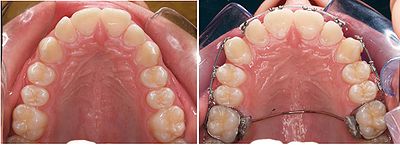
Lingual arch
Encyclopedia

LLA and TPA are fabricated by placing bands on the molars. These are connected to the archwire. The wire can be soldered to the bands or inserted into lingual sheaths welded to the molar band (removable LLA and TPA).
Passive Use
LLA is frequently used as a space maintainer for the lower teeth. In such a case a LLA maintains the molar
Molar (tooth)
Molars are the rearmost and most complicated kind of tooth in most mammals. In many mammals they grind food; hence the Latin name mola, "millstone"....
position.
LLA and TPA can also be used to stabilize molar position in the attempt to avoid side effects that can take place during orthodontic therapy.
As a space maintainer LLA is frequentely used in cases where an early loss of the second deciduous molar takes place. In such a case LLA prevents the molars from migrating mesially (forward) thus blocking off the eruption space for the premolar teeth.
LLA is also used in order to maintain the so called "Leeway space", which is the extra space available in the arch when the second deciduous molar is exfoliated and the second premolar erupts .
Active Use
LLA and TPA, if removable, can also be activated in order to obtain molar movements in all planes of space.
LLA and TPA are more frequently activated to expand or reduce the intermolar distance and to rotate the molars. In this way it is possible to reshape the whole dental arch if molars are connected to the other teeth by means of a buccal archwire.

Stainless steel
In metallurgy, stainless steel, also known as inox steel or inox from French "inoxydable", is defined as a steel alloy with a minimum of 10.5 or 11% chromium content by mass....
with a 0.032" cross section for a passive use.
A beta-titanium
Beta-titanium
Beta titanium alloys exhibit the BCC allotropic form of titanium .Elements in this alloy are titanium, molybdenum, vanadium, columbium, tantalum, manganese, iron, chromium, cobalt, nickel and copper....
wire is more effective if LLA or TPA must be activated to displace molars (Active Use).

